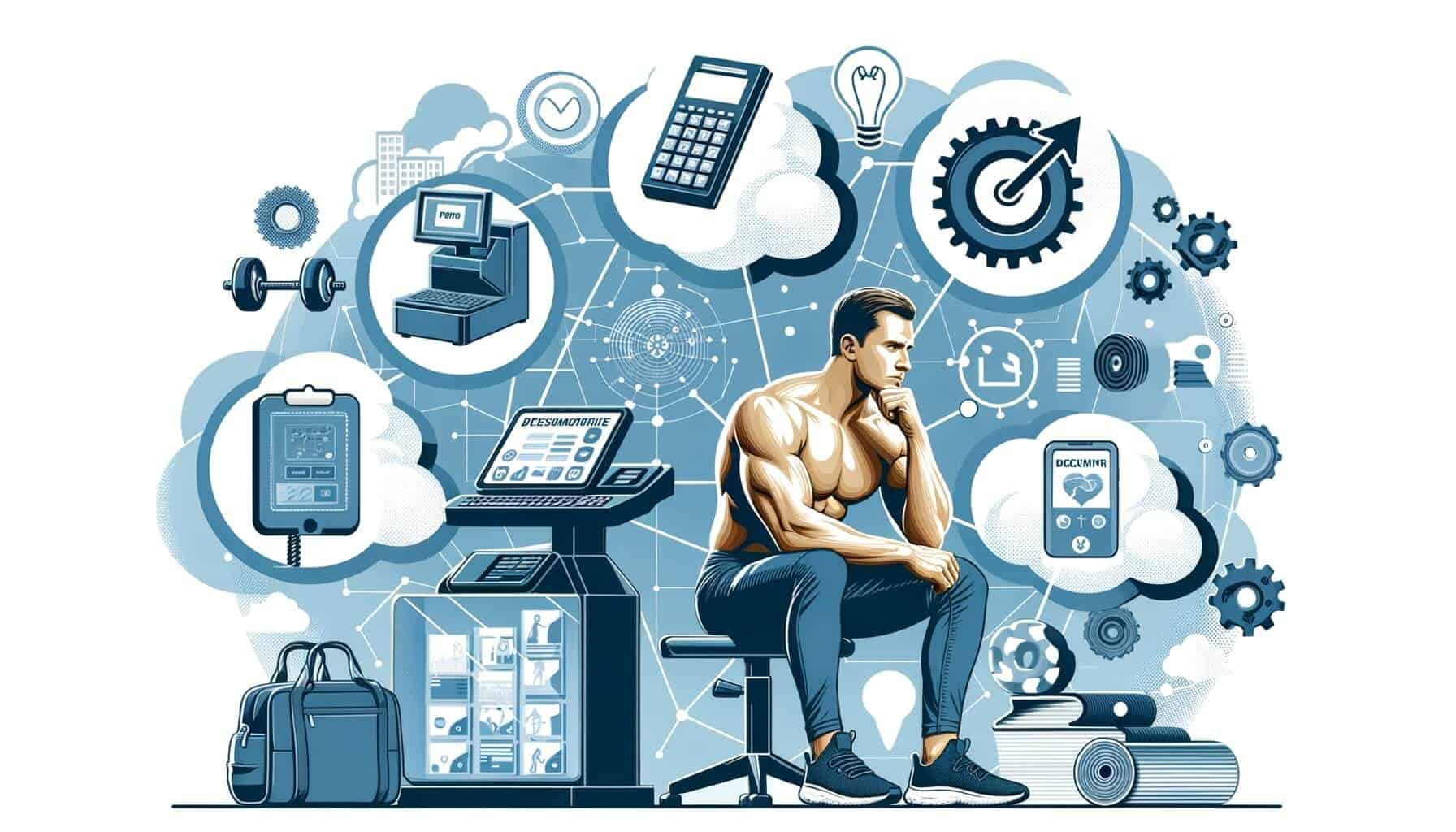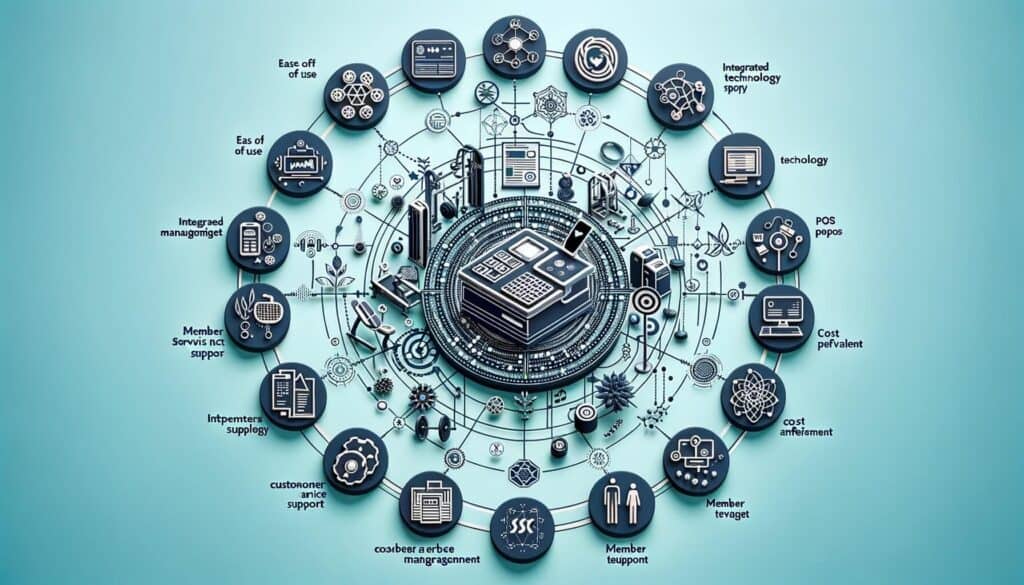
By Amelie Bowen April 13, 2025
In today’s fast-paced world, technology plays a crucial role in the success of businesses across various industries, including the fitness industry. As a gym owner or manager, it is essential to stay up-to-date with the latest technological advancements to streamline your operations and enhance the overall customer experience. One such technology that has revolutionized the way gyms handle transactions is the Point of Sale (POS) system.
A Point of Sale system is a combination of hardware and software that allows businesses to process transactions, manage inventory, track sales, and generate reports. When it comes to gyms, choosing the right POS system is of utmost importance as it can significantly impact the efficiency of your operations, customer satisfaction, and ultimately, your bottom line.
Factors to Consider When Selecting a POS System for Your Gym

Selecting the right Point of Sale system for your gym requires careful consideration of several factors. Here are some key factors to keep in mind during the selection process:
1. Ease of Use: The first factor to consider is the ease of use of the Point of Sale system. Your staff should be able to quickly learn and navigate the system without extensive training. Look for a system with an intuitive interface and user-friendly features.
2. Integration with Gym Management Software: Your POS system should seamlessly integrate with your gym management software. This integration allows for real-time data synchronization, eliminating the need for manual data entry and reducing the chances of errors.
3. Scalability: Consider the future growth and expansion plans of your gym. Choose a Point of Sale system that can scale with your business and accommodate additional features and functionalities as your gym grows.
4. Reporting and Analytics: A robust reporting and analytics feature is essential for tracking sales, monitoring inventory, and gaining insights into customer behavior. Look for a POS system that offers comprehensive reporting capabilities to help you make data-driven decisions.
5. Payment Processing Options: Evaluate the payment processing options offered by the Point of Sale system. It should support various payment methods, including credit cards, debit cards, mobile payments, and contactless payments, to cater to the diverse preferences of your customers.
6. Customer Relationship Management (CRM) Integration: A Point of Sale system that integrates with a CRM software allows you to track customer information, preferences, and purchase history. This integration enables you to personalize your interactions with customers and offer targeted promotions and discounts.
7. Customer Support: Consider the level of customer support provided by the Point of Sale system provider. Ensure that they offer timely and reliable support to address any technical issues or concerns that may arise.
Evaluating the Features and Functionality of Different Point of Sale Systems

Once you have identified the key factors to consider, it is time to evaluate the features and functionality of different POS systems available in the market. Here are some essential features to look for:
1. Transaction Processing: The primary function of a Point of Sale system is to process transactions efficiently. Look for a system that offers fast and reliable transaction processing, minimizing wait times for your customers.
2. Inventory Management: Effective inventory management is crucial for gyms to ensure that they have the right equipment and supplies available at all times. Choose a POS system that allows you to track inventory levels, set reorder points, and generate purchase orders.
3. Appointment Scheduling: If your gym offers personal training sessions or group classes, consider a Point of Sale system that includes appointment scheduling functionality. This feature allows your customers to book appointments online, reducing administrative tasks and improving customer convenience.
4. Membership Management: Membership management is a critical aspect of running a gym. Look for a POS system that offers membership tracking, renewal reminders, and the ability to create customized membership plans.
5. Loyalty Programs: Implementing a loyalty program can help you retain existing customers and attract new ones. Choose a Point of Sale system that supports loyalty programs, allowing you to reward customers for their loyalty and encourage repeat business.
6. Mobile Access: In today’s mobile-driven world, having the ability to access your POS system from anywhere is essential. Look for a system that offers mobile access, allowing you to manage your gym’s operations on the go.
Understanding the Integration Capabilities of a POS System with Your Gym Management Software

Integration between your Point of Sale system and gym management software is crucial for seamless operations and accurate data management. When evaluating POS systems, consider the following integration capabilities:
1. Real-time Data Synchronization: The Point of Sale system should be able to sync data in real-time with your gym management software. This ensures that all transactions, inventory updates, and customer information are instantly updated across both systems.
2. Member Check-in: If your gym management software includes a member check-in feature, ensure that the POS system can integrate with it. This integration allows for a smooth check-in process and accurate tracking of member attendance.
3. Class and Appointment Scheduling: If your gym management software includes class and appointment scheduling functionality, verify that the POS system can integrate with it. This integration ensures that bookings and payments are seamlessly synchronized.
4. Reporting and Analytics: Integration between the Point of Sale system and gym management software enables comprehensive reporting and analytics. This integration allows you to generate reports that provide insights into sales, revenue, member attendance, and other key metrics.
Assessing the Hardware Requirements and Compatibility of a POS System

In addition to the software features, it is essential to assess the hardware requirements and compatibility of a Point of Sale system. Here are some hardware considerations to keep in mind:
1. Terminal Options: POS systems typically require a terminal to process transactions. Evaluate the terminal options offered by the Point of Sale system provider and choose one that suits your needs. Options may include traditional cash registers, touchscreen terminals, or mobile devices.
2. Peripherals: Depending on your specific requirements, you may need additional peripherals such as barcode scanners, receipt printers, cash drawers, and customer displays. Ensure that the POS system is compatible with these peripherals or offers them as part of a package.
3. Internet Connectivity: Most modern Point of Sale systems require an internet connection for real-time data synchronization and payment processing. Assess your gym’s internet connectivity and choose a system that can operate reliably with your existing infrastructure.
4. Mobile Compatibility: If you prefer a mobile Point of Sale system, ensure that it is compatible with the mobile devices you plan to use. Check for compatibility with both iOS and Android devices to cater to a wide range of users.
Comparing Pricing Models and Cost Considerations for POS Systems
When selecting a POS system for your gym, it is crucial to consider the pricing models and cost implications. Here are some common pricing models to be aware of:
1. Upfront Cost: Some POS systems require an upfront payment to purchase the hardware and software licenses. This model may be suitable for gyms with a higher budget or those looking for a one-time investment.
2. Subscription-based Pricing: Many Point of Sale systems offer a subscription-based pricing model, where you pay a monthly or annual fee to use the system. This model is often more affordable for gyms with a limited budget and provides access to regular software updates and customer support.
3. Transaction Fees: Some Point of Sale systems charge a transaction fee for each sale processed through the system. Consider the volume of transactions your gym handles and calculate the potential impact of transaction fees on your overall costs.
4. Additional Costs: In addition to the upfront or subscription costs, be aware of any additional costs associated with the POS system. These may include hardware maintenance, software upgrades, or fees for additional features and integrations.
Exploring Customer Support and Training Options for Your Gym’s POS System
Customer support and training are crucial aspects of implementing a POS system in your gym. Here are some considerations to ensure you receive adequate support:
1. Training: Look for a Point of Sale system provider that offers comprehensive training for your staff. This training should cover system navigation, transaction processing, inventory management, and other essential features. Ensure that the training is tailored to your specific needs and includes ongoing support.
2. Technical Support: Assess the level of technical support provided by the Point of Sale system provider. Ensure that they offer timely assistance for any technical issues or questions that may arise. Look for providers that offer 24/7 support to minimize downtime and disruptions to your operations.
3. Online Resources: Check if the POS system provider offers online resources such as user manuals, video tutorials, and FAQs. These resources can be valuable references for your staff and help them troubleshoot common issues independently.
Security and Data Protection: Ensuring the Safety of Your Gym’s Transactions
Security and data protection are paramount when it comes to handling transactions in your gym. Here are some security considerations for your POS system:
1. Payment Card Industry Data Security Standard (PCI DSS) Compliance: Ensure that the Point of Sale system is PCI DSS compliant. This standard ensures that your customers’ payment card data is securely processed and stored, reducing the risk of data breaches.
2. Encryption: Look for a POS system that uses encryption technology to protect sensitive data during transmission. This ensures that customer information, including credit card details, is securely transmitted between the Point of Sale system and payment processor.
3. User Access Controls: Implement user access controls within the POS system to restrict access to sensitive functions and data. This helps prevent unauthorized access and reduces the risk of internal fraud.
4. Data Backups: Regularly backup your Point of Sale system data to protect against data loss due to hardware failure, theft, or other unforeseen events. Consider cloud-based backup solutions for added security and accessibility.
FAQs
Q1. What is a POS system, and why is it important for gyms?
Answer: A POS system is a combination of hardware and software that allows businesses to process transactions, manage inventory, track sales, and generate reports. For gyms, a POS system is important as it streamlines operations, enhances customer experience, and improves overall efficiency.
Q2. How do I choose the right POS system for my gym?
Answer: When choosing a POS system for your gym, consider factors such as ease of use, integration capabilities, scalability, reporting and analytics, payment processing options, customer relationship management integration, and customer support.
Q3. What features should I look for in a gym POS system?
Answer: Some essential features to look for in a gym POS system include transaction processing, inventory management, appointment scheduling, membership management, loyalty programs, and mobile access.
Q4. How important is integration between the POS system and gym management software?
Answer: Integration between the POS system and gym management software is crucial for seamless operations and accurate data management. It allows for real-time data synchronization, member check-in, class and appointment scheduling, and comprehensive reporting and analytics.
Q5. What are the cost considerations for a gym POS system?
Answer: Cost considerations for a gym POS system include upfront costs, subscription-based pricing, transaction fees, and additional costs such as hardware maintenance and software upgrades.
Conclusion
Choosing the right POS system for your gym is a critical decision that can significantly impact your operations and customer experience. By considering factors such as ease of use, integration capabilities, scalability, reporting and analytics, payment processing options, customer relationship management integration, and customer support, you can make an informed decision. Evaluate the features and functionality of different POS systems, assess the hardware requirements and compatibility, compare pricing models and cost considerations, and explore customer support and training options.
Additionally, prioritize security and data protection to ensure the safety of your gym’s transactions. By following these guidelines, you can select a POS system that meets your gym’s specific needs and helps drive its success in the competitive fitness industry.